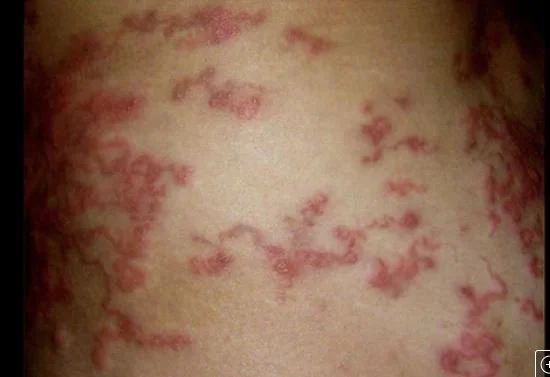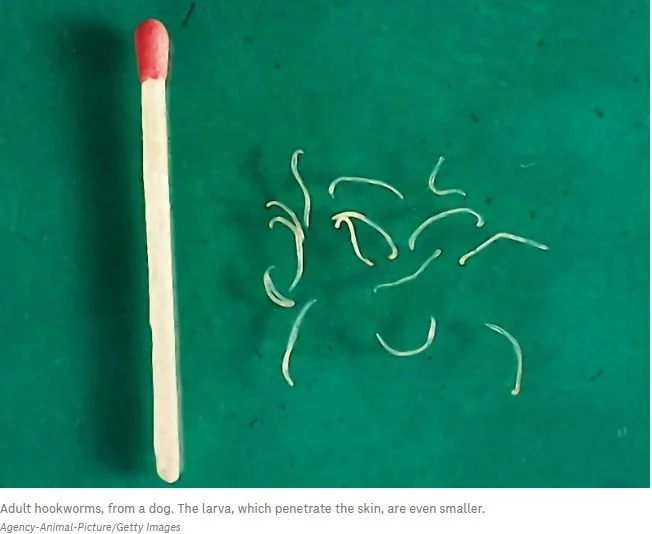A 40 y.o male from Alabama comes in with a pruritic rash.
what is your differential?
Our patient had cutaneous larva migrans caused by hookworms. This condition is transmitted mainly by animal hookworms carried by dogs and cats. Worms burrow into human skin when people come in contact with infected ground or feces.
ANIMAL HOOKWORMS
Animal hookworm larva penetrate the skin and are usually confined there, causing an itchy rash that is serpiginous because they are unable to spread into deeper layers of the skin. In contrast to animal hookworms, the human hookworm is a different species and disseminates through the body. It was thought to have been eradicated in the US however has reappeared in immigrant populations. The picture below is of a 17 y.o. who got cutaneous larva migrans at a Florida beach.
HUMAN HOOKWORMS
Hookworm( including human and animal( is one of the foremost parasitic problems in Florida. The worms were introduced from Africa and worldwide they infect one fifth of the world’s population. Hookworms require three conditions necessary for growth: warm weather, large amounts of rainfall and well drained soil. Necator americanus and Ancylostoma duodenale are the main species that infect humans Human hookworms cause mainly intestinal problems with iron deficiency and protein loss. They block broad spectrum protease inhibitors to neutralize host defenses and down regulate the immune response. Significant morbidity can result in immunosuppressed patients.
hookworm clinic in the US in the 1920’s
LIFE CYCLE
Hookworm is common in the moist tropics and leads to the death of many children by causing iron deficiency anemia and protein loss. The larvae enter the skin and move to the lungs via the bloodstream where they can cause a type I hypersensitivity reaction (Loeffler’s syndrome). They enter the airways and travel up the trachea where they are swallowed. They lodge in the small intestine , where they become adult worms and attach to the intestinal wall. The worms can live there for years; feeding on blood. They mate and lay eggs which enter the stool. In areas of poor sanitation or areas with flooding where sewage backs up into homes, there is a risk of hookworm infection.
IN PREGNANCY
The skin-invasive larvae of this species do not all immediately pass through the lungs and on into the gut, but spread around the body via the circulation, to become dormant inside muscle fibers. In a pregnant woman, after childbirth some or all of these larvae are stimulated to re-enter the circulation (presumably by sudden hormonal changes), then to pass into the mammary glands, so that the newborn baby can receive a large dose of infective larvae through its mother's milk.
The diagnosis of hookworms is not always easy to make since it can present with cutaneous forms and also systemic disease. It can present with cough, diarrhea, abdominal pain or just fatigue from anemia. Often eosinophilia is present especially if there is lung involvement. Individuals may not have eggs in the stool early on since it takes 5-7 weeks for the larva to mature. A PCR is available if suspicion remains high.
Hookworm is easily treated with albendazole and our patient was treated successfully.
FUN FACTS
Although much less commonly than human hookworms, animal hookworms can migrate to the intestine in humans.
Puppies are wormed every two weeks until they are 12 weeks old, then monthly until they are six months old.
Hood M, The present status of hookworm in florida. AJTMH Vol s1-27(4) doi: https://doi.org/10.4269/ajtmh.1947/s1-27.505.
Sanders J, Goraleski K. The hookworm blues:we still got ‘em. Am J Trop Med Hyg. 2017 Nov 8;97(5):1277-1279.
McKenna ML, McAtee S, Bryan PE, Jeun R, Ward T, Kraus J, Bottazzi ME, Hotez PJ, Flowers CC, Mejia R, 2017. Human intestinal parasite burden and poor sanitation in rural alabama. Am J Trop Med Hyg 97: 1623–1628.
Loukas A, Prociv P. Immune responses in hookworm infections. Clin Microbiol Rev. 2001 Oct;14(4):689-703.
Wang C, Lee S, Huang S, et al. Hookworm infection in a healthy adult that manifested as severe eosinophilia and diarrhea. Journal of Microbiology, Immunology and Infection.2011. Dec . Vol 44(6):484-487.




